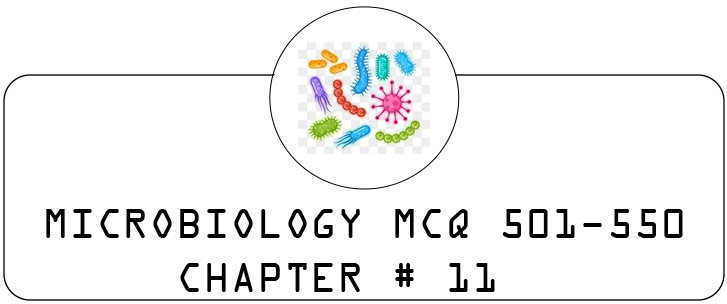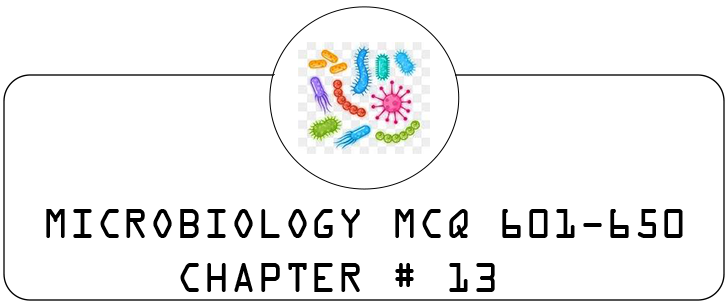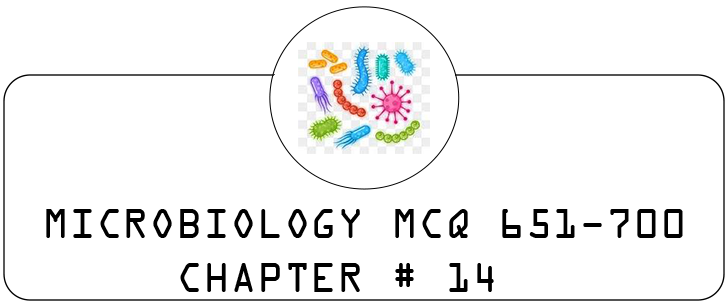
451. Drug resistance transfer by bacteriophage involves:
A. Transformation
B. Conjugation
C. Convocation
D. Transduction ✅
A. Transformation
B. Conjugation
C. Convocation
D. Transduction ✅
452. S. aureus differs from S. epidermidis by:
A. Is coagulase positive ✅
B. Forms white colonies
C. A common cause of UTI
D. Causes endocarditis of prosthetic valve
A. Is coagulase positive ✅
B. Forms white colonies
C. A common cause of UTI
D. Causes endocarditis of prosthetic valve
453. A cook prepared sandwiches for 10 people going for a picnic. Eight out of them develop severe gastroenteritis within 4-6 hrs of consumption of the sandwiches. It is likely that on study the cook is found to be a carrier of:
A. Salmonella typhi
B. Entamoeba histolytica
C. Vibrio cholerae
D. Staphylococcus aureus ✅
A. Salmonella typhi
B. Entamoeba histolytica
C. Vibrio cholerae
D. Staphylococcus aureus ✅
454. Methicillin resistance in S. aureus is due to:
A. β-lactamase
B. MECA gene ✅
C. AMPC gene
D. Porin develop
A. β-lactamase
B. MECA gene ✅
C. AMPC gene
D. Porin develop
455. Acute hematogenous osteomyelitis is commonly caused by:
A. S. aureus ✅
B. Streptococcus pneumoniae
C. E. coli
D. Pneumococcus
A. S. aureus ✅
B. Streptococcus pneumoniae
C. E. coli
D. Pneumococcus
456. Staphylococcus aureus remains in the skin for a longer period because of:
A. Catalase
B. Coagulase ✅
C. DNAase
D. Hyaluronidase
A. Catalase
B. Coagulase ✅
C. DNAase
D. Hyaluronidase
457. Eight months after prosthetic valve replacement, which of the following pathogens can cause infective endocarditis?
A. Staphylococcus aureus
B. Staphylococcus epidermidis ✅
C. Streptococcus viridans
D. Enterococcus faecalis
A. Staphylococcus aureus
B. Staphylococcus epidermidis ✅
C. Streptococcus viridans
D. Enterococcus faecalis
458. Staphylococcus aureus secretes all, EXCEPT:
A. Lipase
B. Cellulose ✅
C. Coagulase
D. Lecithinase
A. Lipase
B. Cellulose ✅
C. Coagulase
D. Lecithinase
459. Lancefield grouping of streptococci is done using:
A. M protein
B. Group C carbohydrate antigen
C. Group C peptidoglycan cell wall ✅
D. M antigen
A. M protein
B. Group C carbohydrate antigen
C. Group C peptidoglycan cell wall ✅
D. M antigen
460. Streptococci causing dental caries:
A. Streptococcus pyogenes
B. Streptococcus mutans ✅
C. Streptococcus pneumoniae
D. Streptococcus bovis
A. Streptococcus pyogenes
B. Streptococcus mutans ✅
C. Streptococcus pneumoniae
D. Streptococcus bovis
461. Quelling phenomenon is seen in:
A. Pneumococcus ✅
B. Streptococcus
C. Staphylococcus
D. Hemophilus
A. Pneumococcus ✅
B. Streptococcus
C. Staphylococcus
D. Hemophilus
462. A person from a village is complaining of the development of pustules. Extract from pus has shown Gram-positive cocci, showing hemolysis, catalase negative, identified as a group of streptococci. Following test is used:
A. Bacitracin sensitivity ✅
B. Novobiocin sensitivity
C. Optochin sensitivity
D. Hemolysis test
A. Bacitracin sensitivity ✅
B. Novobiocin sensitivity
C. Optochin sensitivity
D. Hemolysis test
463. Hot cold phenomenon is seen due to which toxin of staphylococci:
A. Alpha hemolysin
B. Beta hemolysin
C. Gamma hemolysin
D. Theta hemolysin ✅
A. Alpha hemolysin
B. Beta hemolysin
C. Gamma hemolysin
D. Theta hemolysin ✅
464. Staphylococcus differs from Streptococcus by:
A. Coagulase test ✅
B. Phosphatase test
C. Catalase test
D. Gram-negative
A. Coagulase test ✅
B. Phosphatase test
C. Catalase test
D. Gram-negative
465. Which of the following statements is correct regarding non-coagulase Staphylococci?
A. They are non-pathogenic
B. They commonly infect indwelling prosthesis ✅
C. They may cause scarlet fever
D. They are separated by Gram’s staining
A. They are non-pathogenic
B. They commonly infect indwelling prosthesis ✅
C. They may cause scarlet fever
D. They are separated by Gram’s staining
466. Catalase positive, β-hemolytic Staphylococci is:
A. S. aureus ✅
B. S. epidermidis
C. S. saprophyticus
D. Pneumococci
A. S. aureus ✅
B. S. epidermidis
C. S. saprophyticus
D. Pneumococci
467. An infant with neonatal meningitis has a positive CAMP test, the causative agent is:
A. Staphylococcus aureus
B. Streptococcus agalactiae ✅
C. E. coli
D. Haemophilus influenzae
A. Staphylococcus aureus
B. Streptococcus agalactiae ✅
C. E. coli
D. Haemophilus influenzae
468. Most common organism responsible for post-splenectomy infections include:
A. Streptococcus
B. Staphylococcus
C. Pseudomonas
D. Influenza Virus ✅
A. Streptococcus
B. Staphylococcus
C. Pseudomonas
D. Influenza Virus ✅
469. In a case of neonatal meningitis, the pathogen was found to have properties of β-hemolysis, bacitracin resistance, and CAMP positive. Which of the following is most likely the causative agent?
A. Streptococcus pyogenes
B. Streptococcus pneumoniae
C. Streptococcus agalactiae ✅
D. Enterococcus faecalis
A. Streptococcus pyogenes
B. Streptococcus pneumoniae
C. Streptococcus agalactiae ✅
D. Enterococcus faecalis
470. A β-hemolytic bacterial isolate is resistant to vancomycin, shows growth in 6.5% NaCl, and is non-bile sensitive. It is likely to be:
A. Enterococcus faecalis ✅
B. Staphylococcus aureus
C. Streptococcus agalactiae
D. Streptococcus pneumoniae
A. Enterococcus faecalis ✅
B. Staphylococcus aureus
C. Streptococcus agalactiae
D. Streptococcus pneumoniae
471. The substance that acts as a chemical barrier in innate immunity is:
A. Mucus
B. Antimicrobial peptides ✅
C. Neutrophils
D. Macrophages
A. Mucus
B. Antimicrobial peptides ✅
C. Neutrophils
D. Macrophages
472. In the Gram stain procedure, the decolorization step is crucial for differentiating:
A. Gram-positive from Gram-negative bacteria ✅
B. Cocci from bacilli
C. Bacterial species
D. Viable from non-viable cells
A. Gram-positive from Gram-negative bacteria ✅
B. Cocci from bacilli
C. Bacterial species
D. Viable from non-viable cells
473. A microbiological media that supports the growth of a wide variety of organisms is called:
A. Selective media
B. Enrichment media
C. Differential media
D. General purpose media ✅
A. Selective media
B. Enrichment media
C. Differential media
D. General purpose media ✅
474. The appearance of mucoid colonies on culture media is characteristic of:
A. Streptococcus pneumoniae ✅
B. Escherichia coli
C. Salmonella typhi
D. Shigella dysenteriae
A. Streptococcus pneumoniae ✅
B. Escherichia coli
C. Salmonella typhi
D. Shigella dysenteriae
475. An organism that can grow with or without oxygen is called:
A. Obligate aerobe
B. Obligate anaerobe
C. Facultative anaerobe ✅
D. Microaerophilic
A. Obligate aerobe
B. Obligate anaerobe
C. Facultative anaerobe ✅
D. Microaerophilic
476. The technique used to separate and identify different DNA fragments is called:
A. PCR
B. Gel electrophoresis ✅
C. DNA sequencing
D. Cloning
A. PCR
B. Gel electrophoresis ✅
C. DNA sequencing
D. Cloning
477. The main function of the bacterial capsule is:
A. Protection against phagocytosis ✅
B. Nutrient absorption
C. Energy storage
D. DNA replication
A. Protection against phagocytosis ✅
B. Nutrient absorption
C. Energy storage
D. DNA replication
478. The most common cause of urinary tract infections is:
A. Klebsiella pneumoniae
B. Escherichia coli ✅
C. Enterococcus faecalis
D. Proteus mirabilis
A. Klebsiella pneumoniae
B. Escherichia coli ✅
C. Enterococcus faecalis
D. Proteus mirabilis
479. The bacteria that are primarily responsible for the fermentation of lactose in the dairy industry are:
A. Streptococcus thermophilus ✅
B. Lactobacillus bulgaricus
C. Bacillus cereus
D. Enterobacter aerogenes
A. Streptococcus thermophilus ✅
B. Lactobacillus bulgaricus
C. Bacillus cereus
D. Enterobacter aerogenes
480. Which type of bacterial cells possess teichoic acids?
A. Gram-negative
B. Gram-positive ✅
C. Acid-fast
D. Mycoplasma
A. Gram-negative
B. Gram-positive ✅
C. Acid-fast
D. Mycoplasma
481. The virulence factor that enhances the ability of bacteria to attach to host tissues is:
A. Capsule ✅
B. Endotoxin
C. Exotoxin
D. Lipopolysaccharide
A. Capsule ✅
B. Endotoxin
C. Exotoxin
D. Lipopolysaccharide
482. Bacteria that can grow in a high salt concentration are known as:
A. Halophiles ✅
B. Acidophiles
C. Alkaliphiles
D. Psychrophiles
A. Halophiles ✅
B. Acidophiles
C. Alkaliphiles
D. Psychrophiles
483. The cell wall of Gram-positive bacteria contains a high amount of:
A. Lipids
B. Peptidoglycan ✅
C. Proteins
D. Carbohydrates
A. Lipids
B. Peptidoglycan ✅
C. Proteins
D. Carbohydrates
484. The toxin responsible for the symptoms of cholera is:
A. Endotoxin
B. Cytotoxin
C. Enterotoxin ✅
D. Exotoxin
A. Endotoxin
B. Cytotoxin
C. Enterotoxin ✅
D. Exotoxin
485. A common method for counting viable bacterial cells is:
A. Direct microscopic count
B. Viable plate count ✅
C. Turbidity measurement
D. Spectrophotometry
A. Direct microscopic count
B. Viable plate count ✅
C. Turbidity measurement
D. Spectrophotometry
486. Which of the following can be used as a biological indicator for steam sterilization?
A. Bacillus stearothermophilus ✅
B. Clostridium perfringens
C. Staphylococcus aureus
D. Escherichia coli
A. Bacillus stearothermophilus ✅
B. Clostridium perfringens
C. Staphylococcus aureus
D. Escherichia coli
487. The structure responsible for motility in bacteria is:
A. Pilus
B. Flagellum ✅
C. Fimbriae
D. Glycocalyx
A. Pilus
B. Flagellum ✅
C. Fimbriae
D. Glycocalyx
488. Which organism is responsible for the production of penicillin?
A. Streptomyces griseus
B. Penicillium chrysogenum ✅
C. Bacillus subtilis
D. Aspergillus niger
A. Streptomyces griseus
B. Penicillium chrysogenum ✅
C. Bacillus subtilis
D. Aspergillus niger
489. The Gram staining technique is based on the differences in:
A. Cell shape
B. Cell size
C. Cell wall composition ✅
D. Metabolic activity
A. Cell shape
B. Cell size
C. Cell wall composition ✅
D. Metabolic activity
490. The primary immune response is characterized by:
A. Rapid antibody production
B. Memory cell formation
C. Initial low antibody levels ✅
D. High affinity antibodies
A. Rapid antibody production
B. Memory cell formation
C. Initial low antibody levels ✅
D. High affinity antibodies
491. The secondary immune response is characterized by:
A. Faster and stronger response ✅
B. No memory cells
C. Low antibody levels
D. Delayed response
A. Faster and stronger response ✅
B. No memory cells
C. Low antibody levels
D. Delayed response
492. The adaptive immune system primarily involves:
A. Innate responses
B. B and T lymphocytes ✅
C. Phagocytosis
D. Inflammation
A. Innate responses
B. B and T lymphocytes ✅
C. Phagocytosis
D. Inflammation
493. Vaccination works by:
A. Inducing immunity ✅
B. Providing antibodies
C. Killing pathogens
D. None of the above
A. Inducing immunity ✅
B. Providing antibodies
C. Killing pathogens
D. None of the above
494. The test used to determine the effectiveness of an antibiotic is:
A. ELISA
B. Culture and sensitivity ✅
C. PCR
D. Gel electrophoresis
A. ELISA
B. Culture and sensitivity ✅
C. PCR
D. Gel electrophoresis
495. In microbiology, a pure culture is defined as:
A. A culture with one type of organism ✅
B. A culture containing multiple organisms
C. A culture grown on selective media
D. A culture with contaminants
A. A culture with one type of organism ✅
B. A culture containing multiple organisms
C. A culture grown on selective media
D. A culture with contaminants
496. The first line of defense against pathogens is:
A. Innate immunity ✅
B. Adaptive immunity
C. Vaccination
D. Antibodies
A. Innate immunity ✅
B. Adaptive immunity
C. Vaccination
D. Antibodies
497. Which of the following is a viral structure?
A. Capsule
B. Peptidoglycan
C. Capsid ✅
D. Cell wall
A. Capsule
B. Peptidoglycan
C. Capsid ✅
D. Cell wall
498. The method used to increase the amount of DNA in a sample is:
A. DNA sequencing
B. PCR ✅
C. Cloning
D. Electrophoresis
A. DNA sequencing
B. PCR ✅
C. Cloning
D. Electrophoresis
499. The most common type of vaccine is:
A. Inactivated vaccines
B. Live attenuated vaccines ✅
C. Subunit vaccines
D. DNA vaccines
A. Inactivated vaccines
B. Live attenuated vaccines ✅
C. Subunit vaccines
D. DNA vaccines
500. An example of a Gram-negative bacterium is:
A. Staphylococcus aureus
B. Escherichia coli ✅
C. Bacillus subtilis
D. Clostridium tetani
A. Staphylococcus aureus
B. Escherichia coli ✅
C. Bacillus subtilis
D. Clostridium tetani





